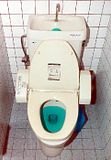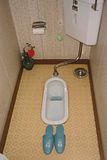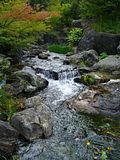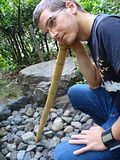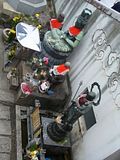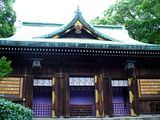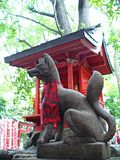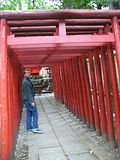Since then, I've spent one week at my school in Niigata and one week at my school in Nishitsubame. I love my Niigata school. My classes were enthusiastic and attentive and actually learned a smidgen of English. My school at Nishitsubame is a different story. The 45 minute walk to the school on the edge of a busy road with no sidewalk (which has been in the rain each time) dampens my mood from the beginning, but all of my classes so far at this school has contained at least one child that is arguably difficult. In my class of two year-olds, I have three that love to climb on the tables and jump off. So far, I've already had one injury at this school and it's only my first week there! I take comfort in knowing that I only have to see these crazy kids once a month for an hour.
We just recently got ONE bike between the two of us, so we haven't been able to do as much exploring as we'd like to, but our goal for this weekend is to find a second. I must say that I'm impressed with the standard Japanese bicycle. Most of them come with a nice front basket, a back rack, a guard over the back wheel (so your pant leg doesn't get stuck inside of it), the most ingenious lock that is permanently installed surreptitiously around the back wheel, a front headlight that's powered by your pedalling, and a very lightweight frame. Plus, it's a beauty. I love this bike!
Nagaoka is okay. As I said, we haven't seen a lot. We've been to what I call Kappa Sushi, because I don't know how to read its true name and it has a picture of a Kappa (cucumber loving swamp creature) on the sign outside its building. It's a kaiten sushi restaurant, which means the sushi comes to you via a conveyor belt. Or you can order a specific dish from a little computer and it comes to you on a little Shinkansen. I love it.
We also visited a very local izekaiya. The outside of this establishment is a crowded mess of tree stumps and furs and Japanese lanterns. The inside is filled with even more junk. There were Noh masks on the walls, bottles of sake shaped like animals, taxidermied blowfish covered in spiderwebs hanging from the ceiling, and a huge bear skin right above my head. We weren't sure it was an izekaiya at first, because we walked in to find an old man laying on tatami mats watching the news and an old woman in a dark room bent over a writing table. Dustin timidly said, "Izekaiya?" The old woman emerged from the darkness and said, "Hai," so we came in to the crowded room devoid of people and took a seat. She served us glasses of sake we assumed were water, because they were served in drinking glasses filled to the brim. Then she preceded to served us various dishes she cooked up in the little kitchen area 6 feet away. We had a surprisingly fabulous meal of daikon with spicy mustard, salted popcorn, edible flowers with soy sauce, and savory mochi (Mochi is like a huge bowl of rice packed down into a deck of cards). We spent the time during our meal trying to communicate with them and occassionally succeeding. They called each other Otosan and Okaasan, Father and Mother, and implored us to do the same. It's the cooleset place in Nagaoka and I don't think it even has a name.
